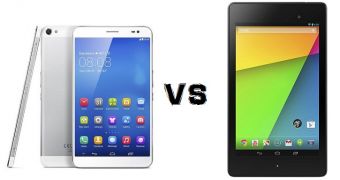Even if larger tablets are expected to hold the spotlight this year, smaller slates are still managing to capture enough of customer attention, with their main selling points being affordability and portability.
Huawei is one of the companies that recently jumped onboard of the 7-inch bandwagon, by launching the MediaPad X1 7.0 at MWC 2014.
Back then, the slate was touted as a worthy Nexus 7 competitor, so for those thinking of purchasing a 7-incher we thought we do a comparison between the two, to give you an idea of which might be capable of answering your needs.
Design, Looks and Feel
The Huawei MediaPad X1 measures 103.9 x 183.5 x 7.18 mm / 4.09 x 7.2 x 0.28 inches so it’s a little bit smaller than the Nexus 7, which still has a convenient size at 114 x 200 x 8.65 mm / 4.4 x 7.8 x 0.3 inches.
The Huawei slate is a little bit lighter, too, (239 g / 0.52 lbs) while the Nexus 7 remains at a comfortable 290 g / 0.6 lbs. However, the Huawei one impresses by boasting a premium feel with an attractive design.
Display
The MediaPad X1 comes bundled with a 7-inch display with 1920 x 1200 pixel resolution. It has a worthy IPS LTPS panel with good viewing angles and it offers great performance in bright conditions too.
The Nexus 7 has the same resolution and size in the screen department, and its IPS screen is coated by a Corning Gorilla Glass (the same applied to the Huawei tablet).
However, the Huawei model offers one extra feat, altering the color temperature to your desired levels.
Hardware
The Huawei MediaPad X1 has a 1.6GHz quad-core chips coming from HiSilicon (Huawei’s own chip manufacturing) fitted with 2GB of RAM and Mali-450 GPU.
On the other hand, the Nexus 7 has a quad-core Qualcomm Snapdragon S4 Pro 1.5GHz chipset powering everything. This is fitted with 2GB of RAM and Adreno 320 GPU.
None of the tablets offers the latest standard in mobile chip architecture, but the performance between the two is pretty well matched. Either way, for daily tasks the two chip platforms are more than enough.
Software
The Nexus can be updated to the latest Android 4.4. KitKat (both 2013 and 2012 version). However, Huawei’s model runs Android 4.2 Jelly Bean out of the , which is skinned with Huawei’s Emotion UI 2.0.
Emotion UI makes everything look quite different. For example, there’s no apps tray and the appearance of settings is changed. On top of that, there’s a range of pre-installed Huawei apps.
But for those who favor a clean approach to things, the Nexus 7 Android interface will appeal without further consideration.
Battery
The Huawei MediaPad X1 embeds a 5000 mAh battery, which is said to be enough to amount to 25 hours of playtime. It also has reverse charge, so that means you can use it to power up your smartphone.
The Nexus 7 has a less impressive 3950 mAh battery, which should last up to 9 hours of use.
Other Functions
The Huawei model has been launched as a 4G LTE device, but there’s also an LTE version for the Nexus 7 (the Verizon variant was just launched).
The Nexus 7 offers either 16GB or 32GB of internal storage, whereas the Huawei has just 16GB but has a microSD card that can be used to expand.
Another important thing you should note is that the Huawei also offers the capacity to place phone calls.

 14 DAY TRIAL //
14 DAY TRIAL //